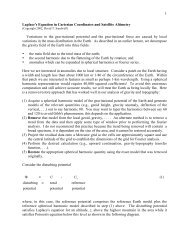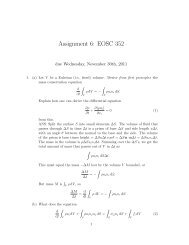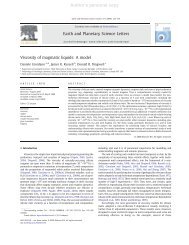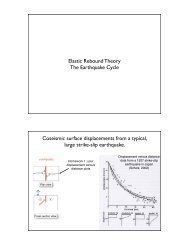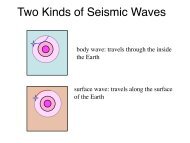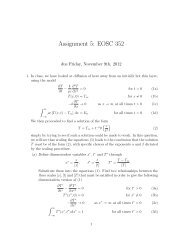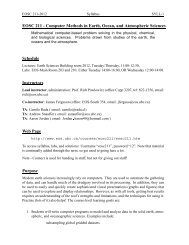Assignment 3: EOSC 352
Assignment 3: EOSC 352
Assignment 3: EOSC 352
Create successful ePaper yourself
Turn your PDF publications into a flip-book with our unique Google optimized e-Paper software.
<strong>Assignment</strong> 3: <strong>EOSC</strong> <strong>352</strong><br />
due Friday, November 5th, 2010<br />
1. So far, we have looked at heat conduction problems without advection. However,<br />
a more general form of the heat equation is<br />
∂T<br />
ρc p<br />
∂t + ρc pu ∂T<br />
∂x − k ∂2 T<br />
= 0. (1)<br />
∂x2 where u is the velocity at which material travels in the x-direction. A setting in<br />
which u is relevant is near the surface of a glacier or ice sheet: snowfall accumulates<br />
at the surface at a rate u. Deformation of ice deeper down in the glacier<br />
or ice sheet then moves ice out from under the surface, keeping the elevation of<br />
the surface fixed even though snow passes through it over time (figure 1). Suppose<br />
we can treat u as constant, and that we have again an imposed temperature<br />
oscillation at the surface x = 0 of the form<br />
T (0, t) = T 0 cos(ωt).<br />
and that heat flux dies off far below the surface,<br />
−k ∂T<br />
∂x<br />
(a) Assume again that we can write<br />
→ 0 as x → ∞. (2)<br />
T = Re[T 0 exp(iωt + λx)].<br />
Substitute this into the heat equation and obtain a quadratic equation for λ.<br />
Note that for u = 0 (i.e., when there is only conduction and no advection),<br />
this equation should reduce to<br />
iω − k<br />
ρc p<br />
λ 2 = 0,<br />
with solution<br />
√ √ ρcp ω<br />
λ = −<br />
2k<br />
− i ρcp ω<br />
2k ,<br />
1
corresponding to<br />
T (x, t) = T 0 exp<br />
( √ ) ( √ )<br />
ρcp ω<br />
−<br />
2k x ρcp ω<br />
cos ωt −<br />
2k x . (3)<br />
(As discussed in class, the other root does not allow the boundary condition<br />
(2) to be satisfied).<br />
(b) In the remainder of the assignment, you should assume that u > 0. What<br />
would the solution for λ be if there was no heat conduction, i.e., if k =<br />
0? Give the corresponding solution for T (x, t) in terms of real quantities<br />
only (your answer should not contain the symbol ‘Re’). How would you<br />
characterize this solution? How does it differ from the solution when there<br />
is no advection and only conduction, given by (3).<br />
(c) In general, thermal conductivity is not equal to zero, and the full quadratic<br />
equation for λ has to be solved. The general solution for a quadratic equation<br />
of the form aλ 2 + bλ + c is<br />
Write λ in the form<br />
λ = −b ± √ b 2 − 4ac<br />
.<br />
2a<br />
λ = α + iβ ± γ √ 1 + iδ, (4)<br />
giving α, β, γ and δ as real quantities that depend on ρ, c p , u, k and ω.<br />
(d) It is not particularly easy to extract the real and imaginary parts of λ from<br />
the solution in equation (4). However, we can approximate the square root<br />
in (4) by using the following result: if x is small, then<br />
√<br />
1 + x ≈ 1 + x/2 − x 2 /8<br />
(This is in fact the first three terms of the Taylor series for √ 1 + x.) Consider<br />
the case of very small δ in (4). Give an approximate solution for λ in terms<br />
of ρ, c p , u, k and ω, bearing in mind that the boundary conditon (2) has to<br />
be satisfied. Also give the corresponding solution for T (x, t) in terms of real<br />
quantities only (your anser should not contain the symbol ‘Re’). Compare<br />
this qualitatively (in two sentences) with the solution for the case where<br />
there is only conduction, equation (3), and with your solution from part (b)<br />
for the case where there is only advection.<br />
(e) Next, consider the case of very large δ. Use the approximation √ √ √ 1 + iδ =<br />
iδ 1 + (iδ)<br />
−1<br />
to find an approximate solution for λ in this case. You will<br />
need to use the fact that 1/i = −i. Give the corresponding solution for<br />
T (x, t) in terms of real quantities only (your anser should not contain the<br />
symbol ‘Re’). Again, compare this qualitatively (in two sentences) with the<br />
solution for the case where there is only conduction, equation (3), and with<br />
your solution from part (b) for the case where there is only advection.<br />
Page 2
(f) For ice, we have the following parameter values: ρ = 910 kg m −3 , c p =<br />
2.1 × 10 3 J kg −1 K −1 , k = 2.2 W m −1 K −1 . A typical rate of snowfall for<br />
an ice sheet is u = 1 m per year. There are different tempearture cycles<br />
relevant to a polar ice sheet. Consider two cases: (i) an annual cycle and (ii)<br />
a Milankovitch cycle of 40,000 years associated with changes in the Earth’s<br />
axis of rotation. Is the approximation of a small or a large δ relevant to (i)<br />
the annual cycle and (ii) the Milankovitch cycle? Let T 0 = 10 K. Plot an<br />
approximate solution for T (x, 0) (i.e. the temperature profile at t = 0) as a<br />
function of x for (i) an annual cycle and (ii) a Milankovitch cycle.<br />
(g) It is possible to identify whether advection is significant compared with conduction<br />
without solving the temperature equation. This is done by scaling<br />
the variables in the equation. Define dimensionless variables through<br />
T = [T ]T ∗ , x = [x]x ∗ , t = [t]t ∗ ,<br />
and choose your scales [T ], [x] and [t] such that the temperature equation<br />
can be written in the form<br />
∂T ∗<br />
∂t ∗<br />
∗<br />
+ P e∂T ∂x − ∂2 T ∗<br />
∗ ∂x = 0 ∗2 for x∗ > 0 (5)<br />
T ∗ (0, t ∗ ) = cos(t ∗ ) at x ∗ = 0<br />
− ∂T ∗<br />
∂x → 0 ∗ as x∗ → 0 (6)<br />
The parameter P e here is known as the Péclet number. Give your scales [T ],<br />
[x] and [t] and the Péclet number P e in terms of the physical parameters ρ,<br />
c p , u, k and ω. When do you expect advection to play a significant role?<br />
Compare P e with the quantity δ defined in part (d). Give the Péclet number<br />
for (i) an annual cycle and (ii) a Milankovitch cycle.<br />
Page 3




